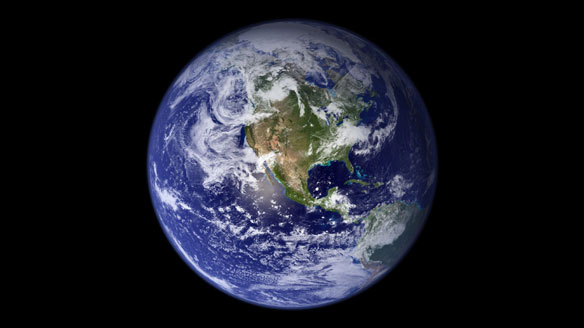The recent 8.8 magnitude earthquake in Chile released so much energy that NASA scientists are saying that it has affected the Earth’s rotation and shortened our days! Richard Gross, a researcher at the Jet Propulsion Laboratory, developed a computer model showing how the earthquake caused the length of the Earth day to be shortened by 1.26 millionths of a second. That is not a noticeable amount by any means, but it still gives us an idea of the immense power of the February 27 quake.
The change in the length of the day came as a result of the shift in the Earth’s axis that occurred because of the quake. The Earth’s figure axis, the imaginary line about which its mass is balanced, shifted by 2.7 milliseconds of arc, or about eight centimetres.
Gross said the same model estimated that the 2007 Sumatran earthquake, with a magnitude of 9.1, should have shortened the length of day by 6.8 millionths of a second, although its shift in the Earth’s axis was only about seven centimetres.
Gross said the smaller Chilean earthquake had a greater effect on the Earth’s rotation because it occurred farther away from the equator. As well, the fault responsible for the Chile quake dips into the Earth at a steeper angle, making it more effective at shifting the axis.
trong earthquakes have altered Earth’s days and its axis in the past. The 9.1 Sumatran earthquake in 2004, which set off a deadly tsunami, should have shortened Earth’s days by 6.8 microseconds and shifted its axis by about 2.76 inches (7 cm, or 2.32 milliarcseconds).
One Earth day is about 24 hours long. Over the course of a year, the length of a day normally changes gradually by one millisecond. It increases in the winter, when the Earth rotates more slowly, and decreases in the summer, Gross has said in the past.
The Chile earthquake was much smaller than the Sumatran temblor, but its effects on the Earth are larger because of its location. Its epicenter was located in the Earth’s mid-latitudes rather than near the equator like the Sumatran event.
The fault responsible for the 2010 Chile quake also slices through Earth at a steeper angle than the Sumatran quake’s fault, NASA scientists said.
“This makes the Chile fault more effective in moving Earth’s mass vertically and hence more effective in shifting Earth’s figure axis,” NASA officials said.
Gross said his findings are based on early data available on the Chile earthquake. As more information about its characteristics are revealed, his prediction of its effects will likely change.
The Chile earthquake has killed more than 700 people and caused widespread devastation in the South American country.
Several major telescopes in Chile’s Atacama Desert have escaped damage, according to the European Southern Observatory managing them.
A salt-measuring NASA satellite instrument destined to be installed on an Argentinean satellite was also undamaged in the earthquake, JPL officials said.
The Aquarius instrument was in the city of Bariloche, Argentina, where it is being installed in the Satelite de Aplicaciones Cientificas (SAC-D) satellite. The satellite integration facility is about 365 miles (588 km) from the Chile quake’s epicenter.
The Aquarius instrument is designed to provide monthly global maps of the ocean’s salt concentration in order to track current circulation and its role in climate change.





The tides will change, the moon still rotates on a constant orbit. KF5HYS
The article says: One Earth day is about 24 hours long. Over the course of a year, the length of a day normally changes gradually by one millisecond. It increases in the winter, when the Earth rotates more slowly, and decreases in the summer, Gross has said in the past.
How can the earth possibly slow down in winter and speed up in summer? Does this mean the southern and northern hemispheres rotate separately from each other? When it’s summer in the northern hemisphere it’s winter in the southern hemisphere. This comment makes no sense!!!